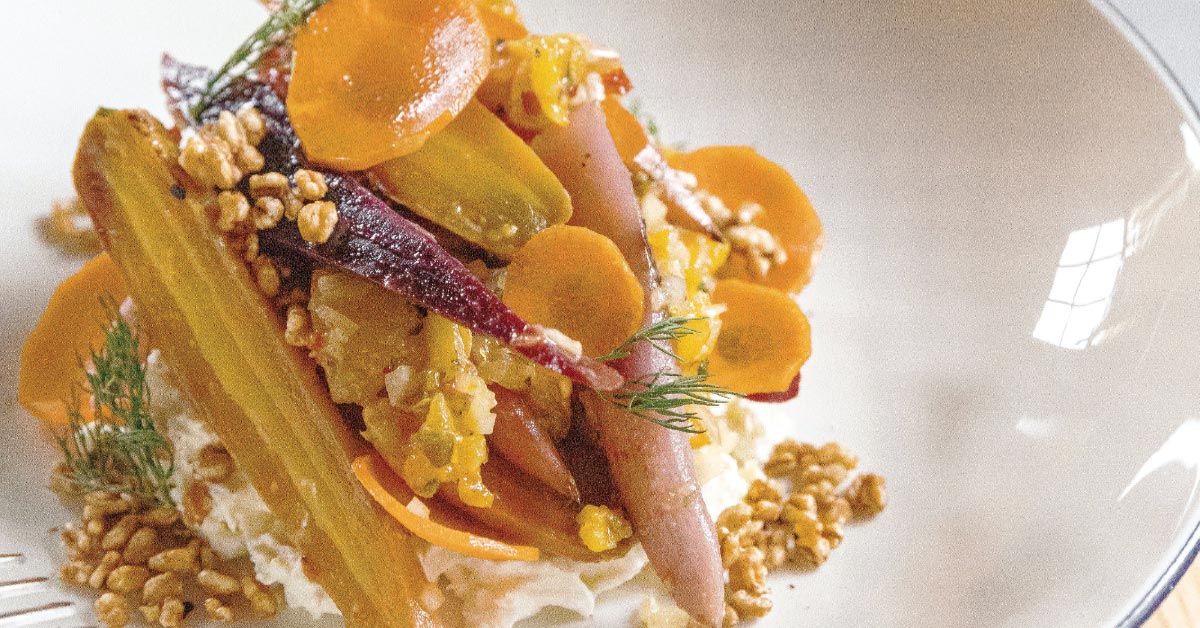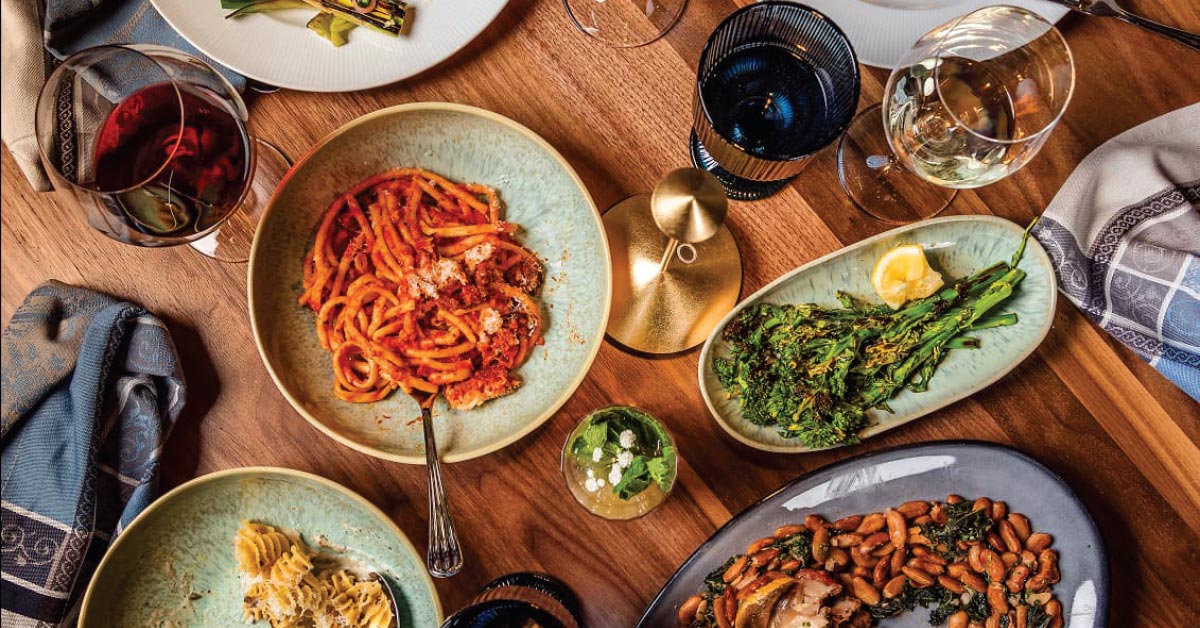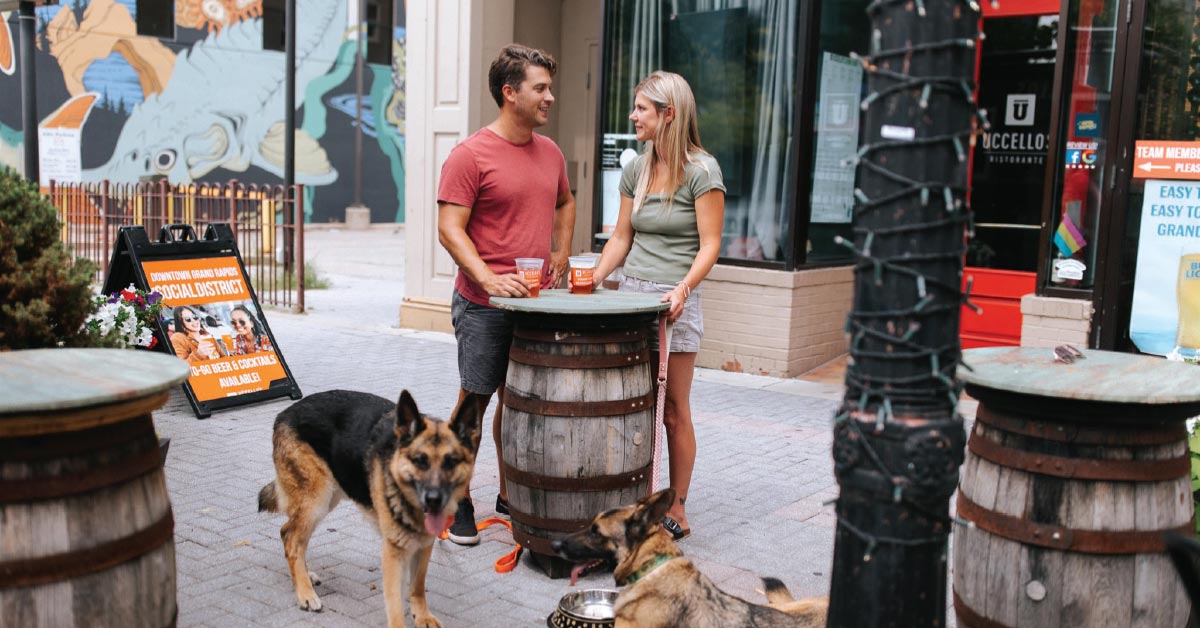It’s fair to guess that the population is divided by some ratio of choosing a restaurant because it offers a favorite dish that can always be relied on, versus the thrill of a special or new item to try for the first time.
Some need the comfort of consistency, while others crave the mystery of the unknown. Grand Rapids is fortunate to have strong players in both categories, but those who change their menu with some regularity aren’t as common. We’re here to spotlight a few of those intrepid trailblazers and find out all the ins and outs of this more challenging (yet also rewarding!) approach.
Featured are:
- Chef Devin and Service Manager Brianna from Grove
- Chef Michael from Café Mamo
- Chef Bob and GM Craig from Friesian
What influenced your decision to change your menu regularly?
Devin/Grove: We find that it keeps things fresh and exciting for both us and our guests. We have a team of people who are passionate and creative, so it allows for us to continue to grow and try new things—and work closely with local farms and businesses who let us know what they have and what’s in season.
Brianna/Grove: There is so much talent on our team and having new ideas and creations in development allows us to foster that talent and watch it grow. This translates to our service team as well. Dining at Grove allows the guest to have a whole experience, not simply a meal.
Craig/Friesian: Mostly for neighbors and potential customers. The neighborhood didn’t want another dive bar, and our neighbors all had their set niche, so we took a more fluid approach and chose to include menu items for vegans, vegetarians, and the gluten free community, to be inclusive and remain approachable enough that we have something for everyone. Our menu isn’t meant to shock and awe you, it’s meant to be inviting and delicious.
Michael/Café Mamo: The easy answer is the seasons. To me, the idea of picking 10 dishes to represent a season is to completely miss the point. With the seasons, trying to boil them down to a single sentence or menu is to remove yourself, and your guests, from actually experiencing them. We don’t work in offices because we don’t want to, so why not change the menu all the time and actually cook, every week, to make something we are proud of and happy to serve?
What kind of process do you go through when creating new dishes?
Devin/Grove: Our team is constantly talking about food and ideas they have or things they’ve seen. So, naturally, most dishes are collaborative or come together from bouncing ideas off each other. We try not to overthink things, trust we know what we’re doing, and just have fun. We also try to just get the highest quality ingredients. That alone gets us excited.
Bob/Friesian: It usually starts with one ingredient or a specific dish, then we consider the time of year, then availability of the product and the type of consumer we are creating for. Once we have a good idea of what we want to do, then we go into the developmental stage (pricing, prep, tasting). However, the biggest part of the process is having a drive to create something that is genuine, and cooking with love.
Michael/Café Mamo: We try and change the menu every Wednesday, but that can vary. The process changes depending on the time of year. In the summer, wheels are always turning, sifting through market produce and fresh sheets from our farmers (shout out to Kessler, Blandford, Green Wagon, Apsey, Polk Street, New Growth, Stillwind... and many more). Summertime is about doing as little as possible and giving people a taste of what West Michigan is. Winter is more like, “How do I make the 37th potato dish of the year?” We lean toward fatty, rich cuts of meat in the winter to keep the menu well flavored.
How does this approach affect your relationship with customers? What are the challenges & benefits?
Devin/Grove: We’ve taken a lot of time to build trust with our guests and it’s paying off. We’ll have items on the menu for only a day or two and see people that dropped what they were doing to come in and try it. We’ve also seen the number of regulars go up because they know they can come in and always try something new or different! The challenges are obvious: Doing this sort of menu takes a lot of time and work. And maybe for the guest, they are no longer able to get a dish that they had enjoyed.
Brianna/Grove: We get to be so much more a part of creating an experience for the guest by sharing our excitement about new dishes. We have certainly found it builds trust with our guests; that they can rely on our team’s innovation and knowledge to create something they will enjoy—and showcase something new and exciting for them to try.
Bob/Friesian: I believe that this approach allows the customers to connect with our food and our heritage.
Craig/Friesian: Challenges are simple: Making sure everything gets switched on the menu on time. Also, some customers don’t like that their favorite item is going away for a seasonal change, so we always make sure that whatever is replacing it is worth it. The benefits are that the menu stays fresh and menu items that don’t sell very well can be replaced carefully.
Michael/Café Mamo: We get folks, nearly every night, that take one look at the menu and say, “your menu online is different.” Our goal is that you come to Café Mamo for some Café Mamo, and trust that we opened a restaurant because we know what we’re doing, and can’t wait to feed you. We have loads of regulars, a lot who have been coming here from the start, and they love that it’s a little different each visit.
The long winter months can be hard. And frequent menu changes make some folks mad. But what I have learned is if you try and make the whole world happy, you won’t be able to keep up. The benefit is that I know all of my farmer’s by name and I have gotten to learn so much about the earth beneath our feet in West Michigan. And when a guest sits down, has a big meal, then comes up to the kitchen to thank us, I get to say, “Don’t thank just us; farmers did most of the work.” I may be some liberal hippie from Montana, but that feels pretty punk rock to me.





